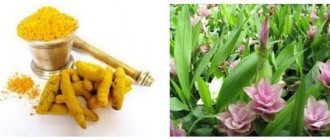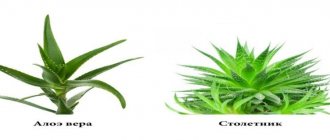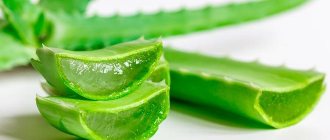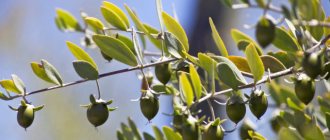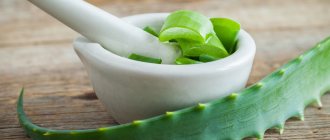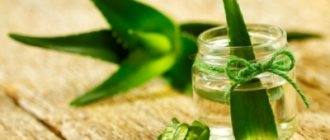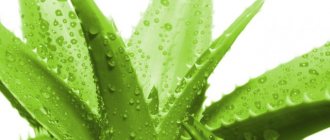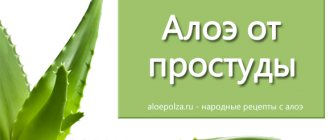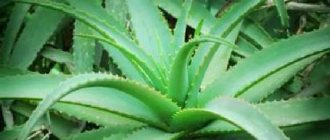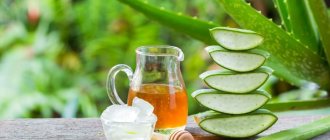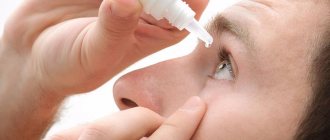Category: Traditional medicine, Succulents Published 11/29/2018 · Comments: · Reading time: 9 min · Views: 15,358
If you make a list of the most popular and effective medicinal plants, then aloe will definitely be included in it - a unique succulent that people have used for medicinal purposes since time immemorial. To this day, it has not only not lost its relevance, but has also received recognition in official medicine and cosmetology.
Today, the most effective method of using aloe is injections. Aloe in ampoules is prescribed as an independent remedy, and is also included in complex therapy for various ailments. It is most widely used in gynecological and cosmetology practice, but is also used for other diseases.
Useful qualities of the plant
Aloe is a common houseplant due to the fact that it is unpretentious to climate change and does not require special care. Despite the fact that this flower can be seen in every second home, most people know little about its healing properties. Aloe juice is most often used. Its beneficial properties and contraindications have been known to people of different nationalities since ancient times. It was used to treat colds and viral infections, treat wounds for antiseptic purposes, and fight dermatological problems and skin burns. To this day, the juice of the plant is widely used in folk medicine.
In fact, the wide spectrum of action of aloe has been confirmed. The medicinal properties and contraindications for the use of this plant for medical purposes have been studied by scientists, doctors and traditional healers for a long time.
With its help, diseases of the female reproductive system, problems of the gastrointestinal tract, inflammatory processes in dentistry, burns and various dermatological diseases are treated. Aloe is used in cosmetology for rejuvenation and elimination of pigmentation and much more.
The medicinal properties of aloe vera are as follows:
- anti-inflammatory;
- antibacterial;
- antifungal;
- moisturizing;
- regenerating;
- soothing and wound healing;
- painkillers;
- immunorestorative.
What do injections help with? Indications for use
The use of aloe vera is contraindicated in some cases, which are:
- Gastrointestinal diseases in acute form.
- Hypertension.
- Kidney and heart failure.
- Uterine bleeding
- Haemorrhoids.
- Cystitis.
- Discharge of blood along with sputum.
- Cystitis.
- Anemia.
- Intestinal obstruction.
In addition to the above contraindications in the form of diseases, it is important to know about age restrictions. Injections are contraindicated for children under 3 years of age.
After three years, the need for injections is decided by the attending physician
The drug should be administered with caution to elderly people.
general information
Aloe is a succulent plant similar to a cactus and a common potted plant. It is widely used in folk medicine (we have already written about this use of aloe), and it is also recognized by ophthalmologists (we also have an article about eye treatment with aloe extract).
Pharmacy chains offer aloe-based preparations in the form of tablets, syrups, pure dried juice, and extracts. Aloe injections are considered one of the most effective ways to deliver medicine to the body.
Description of the drug
The extract is a yellowish or brownish liquid with a specific odor. The active substance is dry aloe extract.
It is obtained from plant leaves preserved in a special way (kept in the dark at low temperature). Auxiliary components: sodium chloride, sterile water for injection.
That is, in fact, nothing extra - just aloe extract.
The drug represents a group of general tonics. It is a choleretic, antiseptic and mild laxative. Increases tissue regeneration, promotes restoration of damaged cells. If reproductive functions are reduced, aloe in ampoules is also prescribed. Instructions for use describe the following indications:
- In ophthalmology: in the complex treatment of inflammatory diseases, destruction of the vitreous body, atrophic changes in the fibers of the optic nerve, myopia, diseases of the cornea and retina;
- In neurology: in the treatment of neuralgia, neuritis, during the adaptation period after strokes, with reduced sense of smell and hearing;
- In pulmonology: in the treatment of respiratory diseases, pneumonia, tuberculosis, bronchitis, bronchial asthma;
- In gastroenterology: in the treatment of conditions characterized by loss of appetite, in diseases of the gastrointestinal tract, except for acute stages;
- In gynecology: for resorption of scars and adhesions, after surgery, in the treatment of chronic inflammation of the genital organs, in the treatment of infertility (including male infertility).
The liquid extract is intended for subcutaneous administration. The recommended daily dose is 1 ml. Children over 5 years old: half the dose daily. Course - up to 50 injections.
Contraindications
The injection drug is not prescribed to children under one year of age. It is prohibited to give aloe injections during acute illness. Contraindications also include pregnancy, kidney failure, hemorrhoids, and cystitis. The extract enhances the effect of laxatives, as well as drugs that affect the functioning of the hematopoietic system.
As a result, long-term use may develop potassium deficiency in the body.
One of the key areas of application of aloe injections is gynecology. The anti-inflammatory and immunomodulatory effect of the drug is used to treat the following gynecological problems:
- Ureaplasmosis and chlamydia;
- Ovarian cysts;
- Chronic inflammation of the appendages;
- Cervical erosions;
- Inflammatory diseases of the ovaries;
- Obstruction of pipes;
- Infertility.
The drug actively suppresses the effect of chlamydia and exhibits excellent absorption properties for ovarian cysts. For erosive processes, the injection of the extract and the local use of aloe preparations are combined. Aloe injections are also used in complex infertility therapy. Reviews of effectiveness come from male and female patients.
Elena Belykh, 29 years old
I used the drug for injection at different times for different reasons. First, I treated inflammation of the appendages. Within 1.5 months of a course of treatment, the chronic disease disappeared (I checked it twice with ultrasound). A year later, the same injections raised low immunity. This is after a number of colds and two sore throats. According to the tests, I am normal.
Maxim Spiridonov, 31 years old
What is a biostimulator?
The concept of “biostimulants” was introduced into medicine by scientist V.P. Filatov. What is it? These are substances that are secreted by living tissue that is on the verge of ceasing its vital activity in order to fight for survival. It was experimentally noted that, in the presence of special conditions, such substances significantly increase a person’s defenses, activate the immune system, and, accordingly, the patient’s health improves, significantly facilitating and accelerating the process of his healing.
Aloe is also capable of producing biostimulating substances. But this requires a series of specific actions with the plant in order to create conditions that are dangerous to its life. For example, it is necessary not to water the flower for two weeks, and then leave the cut leaves for several days in a cool, protected from light place - this way the production of necessary substances is stimulated. It is thanks to this ability that aloe has beneficial properties. And the use of aloe in medicine is also associated with the release of specific biologically active substances from the plant.
How to use the solution externally on the face
The use of aloe extract in cosmetology is widespread, where the described product is added to masks and nutrient media used as rejuvenating and tonic preparations. So, for example, to prepare a moisturizing mask that can smooth out fine expression lines and deep age wrinkles, you will need:
- 1 ampoule of liquid aloe extract;
- a tablespoon of sour cream;
- a teaspoon of castor oil;
- honey in the amount of a teaspoon.
All ingredients need to be mixed and spread evenly over the face for 20 minutes, then wash with warm water. For serious dermatological ailments, for example, a trophic ulcer or burn, the drug is applied to a cotton pad and then the damaged area of skin is treated.
Video recipes for masks with aloe extract
This video is about the use of liquid aloe extract for cosmetic purposes. The author of the video describes the composition and beneficial properties of a particular product, and also shares his own observations and experience regarding the use of aloe as an enhancer of the action of masks, balms and shampoos for hair care.
Injection of aqueous plant extract
But it is much more effective to purchase injections of an aqueous solution of aloe at the pharmacy. The process of their manufacture involves biostimulation, which means that such a medicine has the property of activating the immune system and overall healing of cells. This preparation is called “aloe extract”, popularly known as “aloe injections”. The medicinal properties and contraindications to the medicine are described in detail in the instructions for the drug, which you should definitely read before using the solution.
This drug is packaged in ampoules of 1 ml. The medicine is used to treat both adult patients and children older than one year. The drug is administered, according to indications, subcutaneously into the abdomen or intramuscularly into the thigh or buttock.
Aloe injections have medicinal properties and contraindications, which are described below.
Medicinal properties
Aloe injections, the instructions for use of which indicate a wide scope of their use, have a number of therapeutic properties:
- have a general strengthening and tonic effect;
- stimulate metabolism;
- improve blood supply and nutrition to affected areas of the body;
- increase the rate of cell recovery;
- have an antimicrobial effect;
- improve cellular metabolism and tissue regeneration;
- increase the body's resistance to various factors;
- have immunostimulating properties.
Aloe extract in the form of injections is used only subcutaneously
Indications for injections
Most often, injections of an aqueous solution of the plant are prescribed in ophthalmology, for such diseases of the organs of vision as:
- conjunctivitis;
- vitreous opacification;
- optic nerve atrophy;
- myopia and other pathological conditions.
Injections are also used to treat diseases of the gastrointestinal tract and reduce appetite. The product is used for bronchitis and pneumonia, burns, scar tissue changes, as well as in cosmetology.
Aloe injections are often prescribed after surgical interventions in order to restore the body's strength and speed up the recovery period.
Benefits of aloe injections
The administration of the drug has a positive effect on the body:
- anti-inflammatory effect, relieving swelling, redness, itching, which are formed when immune cells accumulate in the affected area;
- antimicrobial effect, which increases with additional alcohol content in the preparation; coccal flora, intestinal infection, and tuberculosis bacteria are destroyed;
- stimulation of the immune system due to the increased content of microelements, vitamins, minerals in injections with aloe;
- stimulation of digestion due to the presence of vitamins and enzymes in the composition; in addition, a person’s appetite increases, and the act of defecation is activated;
- tonic effect on the entire body;
- regeneration of damaged surfaces of tissues and organs resulting from chronic diseases;
- increasing blood flow speed;
- nutrition of organs and tissues with useful substances, microelements, minerals, vitamins.
Due to its anti-inflammatory, antibacterial, regenerating effects, the solution is often prescribed for postoperative conditions. The patient's body recovers faster and the tissues heal.
plant juice is used to make aloe extract
Plant extract injections for women's health
What are the medicinal properties and contraindications of aloe injections, reviews in gynecology? The effectiveness of such a remedy has also been noted in gynecology, andrology and urology in the treatment of inflammatory diseases and infertility. Recently, one can increasingly hear recommendations for couples planning to conceive a baby to undergo a preventive course of herbal injections. It has been noticed that after such treatment, pregnancy occurs faster, and the risk of developing various pathologies during the entire period of gestation is reduced. In addition, reviews indicate that the expectant mother, who strengthened her immune system before pregnancy with the help of injections of flower extract, is much less susceptible to contracting respiratory and infectious diseases.
In gynecology, with the help of aloe injections, which are part of complex therapy, diseases such as:
- sexually transmitted infections: chlamydia, ureaplasmosis, mycoplasmosis;
- cysts;
- cervical erosion;
- obstruction of the fallopian tubes;
- inflammatory processes of the mucous membrane and appendages.
In some cases, for example, when treating cervical erosion, the doctor may prescribe not only injections, but also the intravaginal insertion of a tampon soaked in an aqueous solution of aloe. This treatment regimen significantly increases the effectiveness of the drug and speeds up the healing process.
Dosage and course
Aloe injections exhibit their medicinal properties only when used correctly, namely:
For subcutaneous administration (arm, abdominal area), a solution is used that is slowly absorbed into the blood and therefore has a progressive effect. 1 procedure per 1 ml per day is enough. The maximum allowable amount per day is 4 ml. The event is also intended for children from 3 years old, but for them the volume will be different.
Aloe injections intramuscularly (thigh, buttock) are often practiced contrary to the instructions and at the insistence of the attending physician, which ensures a quick effect. The injection is given in the same minimum dosage - 1 time per 1 ml for an adult. For a child – 0.3 or 0.5 ml (from 3 and from 5 years old, respectively).
Intravenous injections of the solution are not practiced. The full course of treatment is usually long and includes from 30 to 50 procedures. The regimen of use may vary, depending on the form and severity of the disease. Thus, for tuberculosis patients, 0.2 ml is prescribed, followed by a dynamic increase in the dose, and for bronchial asthma, the injections remain unchanged for 3 weeks, after which they are given once every 2 days.
Advice! To avoid visiting your local clinic every day for more than a month, you can learn how to do the procedures correctly at home - on your own or with the help of a loved one.
Many patients are interested in how to inject aloe painlessly, because often both subcutaneous and intramuscular administration of the drug causes aching and lasting sensations of discomfort. A positive effect can be achieved by using a small dose of novocaine. In addition, a medical syringe with a necessarily thin needle must be inserted into the skin or muscle slowly and gradually. In addition, vitamins of groups B1, B6 and B12 are usually prescribed to heal irritated areas and generally normalize well-being.
Important! Allergy sufferers should not think about how to give an injection. The thing is that in such patients the medicine can provoke the appearance of numerous skin rashes, itching, hyperemia, and sometimes, in case of overdose, cause anaphylactic shock, nausea, vomiting, diarrhea, increased body temperature and blood pressure.
Contraindications
What are the medicinal properties and contraindications of aloe injections? Despite the wide spectrum of action, the preparation of an aqueous infusion of the plant extract is not recommended for use in some conditions. So, you cannot resort to this method when:
- pregnancy;
- under 1 year of age;
- cystitis;
- diseases in an acute form, especially with problems of the digestive tract;
- renal failure;
- problems with the heart and blood vessels;
- When treating elderly and senile people, special supervision by a specialist is required.
The use of aloe injections in gynecology
Liquid extract of succulent is used as a biostimulant as part of complex therapy for chronic diseases:
- in pulmonology (pneumonia, chronic bronchitis);
- in gynecology (adnexitis, endometritis);
- in gastroenterology (peptic ulcer of the stomach and duodenum);
- in dermatology (trophic ulcers).
Gynecology
Aloe injections in gynecology are prescribed for:
- adnexitis;
- endometritis;
- vulvitis;
- genital warts;
- mycoplasmosis, chlamydia, ureaplasmosis and other sexually transmitted infections;
- inflammation, erosion of the cervix;
- obstruction of the fallopian tubes.
Aloe injections will also help to quickly rehabilitate after surgery, for which purpose in gynecology they are prescribed in the postoperative period. They have an immunomodulatory effect, fight inflammatory processes, help the body recover quickly - the scope of application of aloe injections in gynecology is wide. Medicinal properties of aloe.
Gastroenterology
Liquid aloe extract for injection is used for gastrointestinal diseases. Aloe injections have the following effects:
- help in stopping the inflammatory process during gastritis;
- fight infections;
- help in the treatment of gastric and duodenal ulcers due to their anti-inflammatory, antimicrobial effects;
- relieve pain accompanying indigestion.
Chronic respiratory diseases
Aloe injections are used in pulmonology to treat diseases such as:
- bronchial asthma;
- pneumonia (aloe for cough);
- Chronical bronchitis;
- tuberculosis.
Trophic ulcers
Liquid extract for injection is a clear liquid, sometimes with sediment, with a yellowish or reddish-brown color and a pleasant smell of fresh fruit. The drug is sold in ampoules of 1 ml, which corresponds to the daily requirement for an adult.
Like many medications, the liquid extract has contraindications. The medicine is prescribed to patients over one year of age, the dosage is selected together with the attending physician. The extract is injected subcutaneously into the forearm or abdomen, or intramuscularly into the thigh or buttock. The procedure itself causes unpleasant painful sensations, so it is recommended to alternate the injection area and treat the injection site with iodine.
Injections of an aqueous solution of aloe are recommended in the following cases:
- for eye diseases;
- skin lesions;
- for problems in the functioning of the genitourinary system;
- for bronchial asthma;
- for metabolic disorders.
Injections of aloe solution are widely used to normalize the functioning of the stomach and intestines, in case of excess weight to reduce appetite and restore metabolism. The drug is also used for bronchitis and pneumonia, burns, skin damage, and in cosmetology. During surgery, injections of aloe extract are recommended for a full recovery and accelerated restoration of the human body’s resources during the rehabilitation period.
Liquid aloe solution is popular among urologists, gynecologists and andrologists. These injections are highly effective in treating reproductive function and various inflammations of the genital organs. A course of treatment will be useful for couples wishing to have a child. After such prevention, it is easier to achieve the desired pregnancy, and the intrauterine period of the baby’s development will be painless with minimal risk of congenital defects. And the potential parent will gain lasting immunity to acute respiratory infections and influenza.
Many gynecologists recommend including injections in a set of procedures to combat many diseases, for example, genital infections, tubal obstruction, erosion, inflammation of the mucous membrane and appendages.
In the case of simultaneous use of aloe vera ampoules with medications that enhance hematopoietic functions or with iron supplements, an increase in effectiveness is observed. The parallel use of the extract with diuretics, corticosteroids, and drugs containing licorice root is unacceptable. With this combination, there is a lack of potassium in the body.
Long-term use of this drug also leads to a decrease in potassium levels, which manifests itself in increased negative effects. It is not recommended to combine the liquid extract with antiarrhythmic drugs and cardiac glycosides. If it is necessary to administer painkillers, the procedure must be carried out with a new syringe. It is unacceptable to mix the extract with any liquid medicines in one bottle.
Dosage
Only a specialist can prescribe the dosage of the drug and course of treatment required in a particular case. Most often, for adults, the daily dose of an aqueous solution of aloe is 1 ml, that is, 1 ampoule. For children, depending on age, the dosage is 0.2-0.5 ml.
The course of treatment depends on the complexity of the condition and the medical goals set. On average it ranges from 15 to 30 days. If the problem has not been resolved within the specified period, a break of several months is required, after which you can take the course again.
Beneficial properties of aloe in injections
The benefit of concentrated aloe vera extract for intramuscular administration lies in the main effects of the plant: anti-inflammatory, strengthening and antibacterial. Aloe injections help against pneumonia, gynecological diseases and other ailments due to the following effects:
WE RECOMMEND THE ARTICLE!
Chaga mushroom has long been used in folk medicine to treat stomach ulcers, gastritis, and oncology. Read more >>
- tone;
- strengthen;
- stimulate metabolism;
- nourish;
- improve blood flow;
- destroy harmful microbes;
- increase the ability to regenerate cells;
- stimulate the immune system.
The biostimulant is prescribed for inflammation of internal organs and for recovery after surgery. The dosage and therapeutic course are determined only by the doctor. Injections should also only be given if you have experience; if you lack it, it is better to turn to specialists for the procedure.
Despite the positive properties of aloe and its use in folk medicine, you cannot give injections without a doctor’s advice!
The plant extract is also used to alleviate chronic diseases of internal organs.
Maintenance therapy is not prescribed during an exacerbation. If negative effects occur or your general condition worsens, be sure to consult your doctor.
How to give aloe injections
Injections are given intramuscularly; there is no need to try to get into a vein. In addition to the ampoules, you will need a sterile syringe, disinfectant and cotton wool. Instructions:
- Open the ampoule, draw the liquid extract into a syringe, try to release a small amount of the product to expel the air.
- Wipe the area of skin where the injection will be given with a disinfectant.
- Insert the syringe needle under the skin approximately 2 thirds of its length, hold at an angle of about 45 degrees.
- Inject the product.
- Apply a cotton swab already soaked in alcohol to the injection site.
Injection is required exclusively subcutaneously. The extract should not be injected into a vein. If you are afraid that you will do something wrong on your own, seek help from specialists or more experienced loved ones. Injection site: buttock, thigh, abdomen, shoulders.
Injections can be very painful, so it makes sense to first inject a solution of novocaine.
Therapeutic injections of the extract should not be placed in the same place all the time. The process is painful, and bruises may remain at the injection sites even if they are performed by professional nurses. So change places.
[media=
https://youtu.be/3iX4LO3ZaT4
]
Dosage of bioregulatory drug
The dosage is determined solely by the attending physician. Usually no more than 1 ml of the drug per day is used. This amount of extract is contained in the ampoule of the product. Do not exceed 4 ml. The recommended dose for children is no more than 0.5 ml. The course can be continued for up to 30 days, repeated after a break of 60-90 days, if such a need arises. The method of application is always subcutaneous, not intravenous.
Aloe injections: medicinal properties and contraindications, price
The cost of 10 ampoules of 1 ml of aloe aqueous solution for injection is on average 200 rubles. That is, such a drug is available to many patients. But, taking into account contraindications and possible adverse reactions, before purchasing such a medicine, you should consult with a specialist about the advisability of its use in a particular case.
Instructions for using injections and dosage
It is necessary to begin with the fact that aloe extract, presented in ampoule form, can be used as intramuscular injections or orally in its pure form. Methods of external use for some dermatological problems are also possible. It is worth noting that the medication can be prescribed starting from the age of three.
Orally, adults should take a teaspoon three times a day for one month. For children under five years of age, the maximum dose is 10 drops, for adolescents - half a teaspoon, and the medication regimen does not change. Between treatment courses there should be a break of three to four months.
As for injections, the maximum dosage for an adult is 1 milliliter three times a day. For children under five years old - 0.3 ml, and for children over five, injections are administered at 0.5 milliliters intramuscularly. The course of injections consists of 30-50 injections. For some diseases, such as tuberculosis or asthma, the dosage may be dynamic, starting from 0.2 milliliters to 4 milliliters per day.
Video: how to give an intramuscular injection correctly
This video is an excerpt from a popular medical television show, which shows the injection process. The type of injections described is intramuscular in nature. After familiarizing yourself with the material offered for viewing, you can learn how to make intramuscular injections yourself without harming the patient.
Reviews
It is quite difficult to come across a negative review about a product such as aloe injections. Possessing a biogenic effect and being a natural medicine proven over generations, it has an immunorestorative effect. After aloe injections, metabolism, hematopoiesis and regenerative processes improve. The body, as they say, is saturated with useful substances before our eyes, gaining strength to fight various diseases.
There is a high effectiveness of aloe injections in the treatment of infertility associated with hormonal disorders and inflammatory processes. This method is prescribed for both therapeutic and preventive purposes before a planned pregnancy to strengthen the immune system and restore the functioning of internal organs.
In the treatment of sexually transmitted infectious diseases, doctors and patients note that aloe injections significantly reduce the risk of developing complications after taking medications such as candidiasis and vaginal microflora disorders.
Among the disadvantages, there is a high degree of pain from the injection and frequent cases of adverse reactions.
We found out that aloe injections have medicinal properties and contraindications. When deciding to take such a drug, you should weigh all the factors and risks.
Indications for procedures
For what diseases should you use pharmaceutical herbal medicines? The extract has a wide range of indications. It is used not only in medicine, but also in cosmetology. The phytosolution is added to anti-aging face masks, nutritional compositions to stimulate hair growth, products to strengthen nails and whiten the skin of the hands.
Ampoules with liquid extract will be useful in the following situations:
- for diseases of the male genital area - aloe injections for stagnant prostatitis restore blood circulation, relieve inflammation, and activate local immunity. The product is enriched with zinc and antitumor components;
- for gynecological ailments - the product normalizes the condition of the mucous membrane, improves microflora, suppresses the activity of Candida fungi, regulates blood circulation in the pelvic organs. Women may be recommended aloe injections for adhesions in the fallopian tubes. The medicinal gel promotes the resorption of formations and improves metabolic processes at the cellular level. Treatment of female infertility also involves the use of herbal remedies;
- for diseases of the bronchopulmonary system - with the help of agave, pneumonia is successfully treated at an early stage. Aloe injections have worked well for bronchitis. The product promotes the removal of sputum, blocks inflammation, boosts the immune system;
- for ophthalmological pathologies - the extract is effective for glaucoma. The biostimulator improves the condition of the cornea and retina and prevents premature wear of the lens.
We recommend: Aloe for bronchitis - useful recipes
Injections will be useful for vascular pathologies: varicose veins, hemorrhoids, atherosclerosis. The product improves blood circulation, prevents blood clots and congestion. It is useful to inject the liquid extract after a stroke. This promotes faster recovery of brain cells and has a positive effect on hearing and vision. The plant will improve well-being with gastritis, neuralgic disorders, and iron deficiency anemia.
Aloe solution in cosmetology
Due to the pain of aloe injections, injections are not used for facial care. But the solution in ampoules is used externally, adding it to various cosmetics, such as masks or lotions. Such cosmetics enriched with aloe extract have rejuvenating properties, eliminate age spots and inflammation, improve complexion, fight rashes, tighten the skin, moisturize and protect it from external factors. Regular care of the skin of the face and body with the help of such cosmetics will significantly improve your appearance, improve your health and eliminate signs of aging.
In this material, we described the medicinal properties of aloe vera and found out that this plant is used for medicinal purposes in a variety of ways. But the advantages of injections are that in this way the beneficial substances produce a healing effect much faster and more effectively. And in addition, they act on the body as a whole, activating general immunity, restoring and strengthening strength.
Liquid aloe extract in ampoules
Liquid succulent extract is a biostimulant - a biologically active substance that can have a stimulating effect on any organ or on the vital functions of the entire organism. Aloe in injections has a wide range of pharmacological effects: anti-inflammatory, regenerating, antiseptic.
The active component of the medicinal solution includes:
- hydroxymethylanthraquinone;
- homonataloin;
- aloin;
- nataloin;
- glycosides;
- micro- and macroelements and vitamins of different groups, including B, C and E.
Aloe extract in the form of a solution for subcutaneous administration in ampoules is a yellow to brown liquid with a characteristic odor. Contains dry aloe extract, sodium chloride and water.
